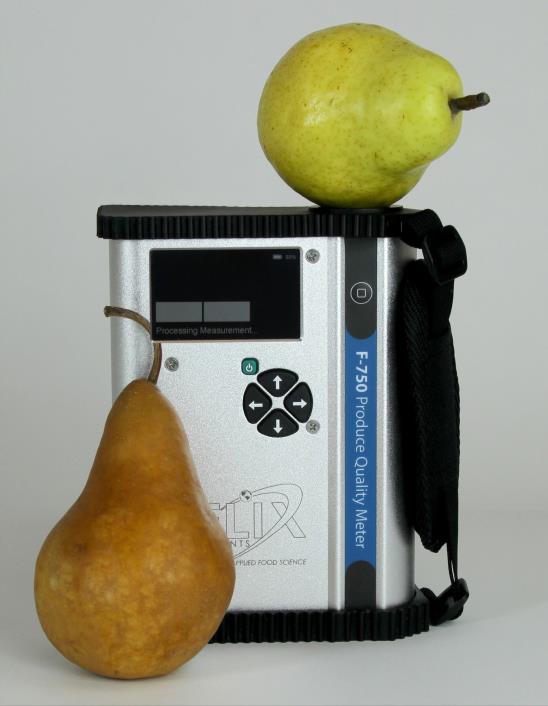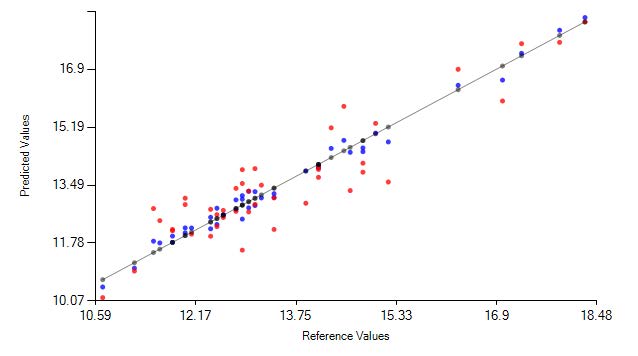April 21, 2016 at 11:06 pm | Updated April 21, 2016 at 11:06 pm | 3 min read
Non-destructive measurements of internal quality indicators for ANJOU AND BOSC PEARS, PYRUS COMMUNIS
Sugar content is an important metric in determining proper harvest time and eating quality in pears. The ability to quickly and accurately measure the internal properties of a fruit helps save time and money, especially when non-destructive methods are used. To determine effectiveness and viability of the F-750 Produce Quality Meter in measuring internal sugar content, a study was carried out sampling 45 Anjou and Bosc pears. A refractometer was used to collect reference values of total soluble solids, a representative value for ºBrix. Measured values were correlated with the spectral data collected on the F-750, and results show that the F-750 Produce Quality Meter precisely and non-destructively measures total soluble solids, with a calculated root mean square error of prediction of 0.74 TSS. Similar results have been found for other pear varieties, and the F-750 has been validated for measurements of other fruit metrics such as dry matter and acidity.
Materials and Methods:
Subscribe to the Felix instruments Weekly article series.
By submitting this form, you are consenting to receive marketing emails from: . You can revoke your consent to receive emails at any time by using the SafeUnsubscribe® link, found at the bottom of every email. Emails are serviced by Constant Contact
In March 2015, 45 pears were measured using an F-750 Produce Quality Meter. Pears were selected across a range of colors and sizes. Next, the same pear regions measured with the F-750 were destructively measured for total soluble solids (TSS) using a refractometer. These reference values were analyzed alongside the spectral data collected with the instrument using the Model Builder software included with the F-750. A spectral rang of 729-975 nm was used with the Model Builder software to detect correlations between the spectral signal and TSS. The resulting data were analyzed for linearity, root mean squared error, and cross validation error to determine the applicability and accuracy of the created model. This experiment was repeated with five additional F-750’s to determine repeatability and consistency in building a TSS model for pears.

Figure 1. F-750 in the process of measuring pears.
Results and Discussion:
Results show that the F-750 Produce Quality Meter precisely and non-destructively measures the internal properties of pears. A strong correlation between spectral data and collected reference values is illustrated by a model prediction R2 of 0.95. Figure 2 displays this correlation and demonstrates the consistency of measurement. A calculated root mean square error of cross validation (RMSECV) of 0.74 further illustrates the accuracy of the created model. This RMSECV value indicates the amount of error ºBrix the model is expected to display for a given measurement when loaded onto the F-750 and used to predict TSS. Both Bosc and Anjou pears were used in this study, and no differences in performance were detected between the two varieties for the spectral range selected.

Figure 2. Prediction error for pears using the F-750. Specimen most strongly correlated to the calculated trend line show the greatest accuracy of prediction (Red; Cross validation Prediction, Blue; Training set prediction).
Conclusions:
The F-750 Produce Quality Meter accurately predicted TSS using both Anjou and Bosc pears. Other tests and research findings (See Further Reading and Supporting Science section below) have demonstrated the ability to measure other important internal fruit metrics such as dry matter and acidity with the F-750. We expect similar results with other pear varieties.
Further Reading and Supporting Science:
Li, Jiangbo et al. (2014) A comparative study for the quantitative determination of soluble solids content, pH and firmness of pears by Vis/NIR spectroscopy. Journal of Food Engineering. 116(2) 324-332.
Liu, Yande and Ying, Yibin (2005) Optical system for measurement of internal pear quality using near-infrared spectroscopy. Optical Engineering, 44(7) 076403.
Paz, Patricia et al. (2009) Instantaneous quantitative and qualitative assessment of pear quality using near infrared spectroscopy. Computers and Electronics in Agriculture. 69(1) 24-32.
Related Products
- F-751 Grape Quality Meter
- Custom Model Building
- F-901 AccuStore
- F-751 Melon Quality Meter
- F-751 Kiwifruit Quality Meter
- F-750 Produce Quality Meter
- F-751 Avocado Quality Meter
- F-751 Mango Quality Meter
- F-900 Portable Ethylene Analyzer
- F-950 Three Gas Analyzer
- F-920 Check It! Gas Analyzer
- F-960 Ripen It! Gas Analyzer
- F-940 Store It! Gas Analyzer
Most Popular Articles
- Spectrophotometry in 2023
- The Importance of Food Quality Testing
- NIR Applications in Agriculture – Everything…
- The 5 Most Important Parameters in Produce Quality Control
- Melon Fruit: Quality, Production & Physiology
- Guide to Fresh Fruit Quality Control
- Fruit Respiration Impact on Fruit Quality
- Liquid Spectrophotometry & Food Industry Applications
- Ethylene (C2H4) – Ripening, Crops & Agriculture
- Active Packaging: What it is and why it’s important


